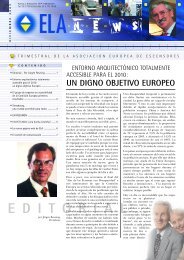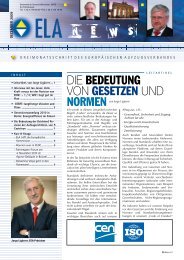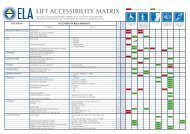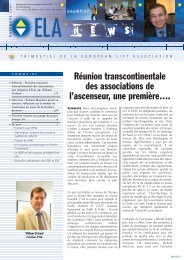WP6-Brochure-E4 brochure - ELA European Lift Association.
WP6-Brochure-E4 brochure - ELA European Lift Association.
WP6-Brochure-E4 brochure - ELA European Lift Association.
Create successful ePaper yourself
Turn your PDF publications into a flip-book with our unique Google optimized e-Paper software.
To take into account the effect of the counterweight, a balancing factor is used, as shown in<br />
Table 5‐3.<br />
Table 5‐3. Balancing factor c bal<br />
Type of <strong>Lift</strong><br />
c bal<br />
Traction lift 50% balanced 0,50<br />
Hydraulic lift no balanced 0<br />
Since precise information about the use of the lift in the building is not readily available, the<br />
following assumptions for the calculation of the lifts travel distance are taken:<br />
Table 5‐4. Average travel distance factor C atd<br />
Quantity of stops<br />
Average Travel Distance c atd<br />
2 stop building maximum travel distance (lowest to topmost floor)<br />
more stop building<br />
more than one lift forming a group<br />
of lifts in a more than 2 stop<br />
building<br />
0,5 * maximum travel distance (lowest to topmost floor)<br />
0,3 * maximum travel distance (lowest to topmost floor)<br />
For the measurement of active power escalators/moving walks are run for 5 minutes in the<br />
up/forward direction and for another 5 minutes in low‐speed mode (when existing). The standby<br />
power in escalators is measured with the escalator/moving walk stopped.<br />
Once again, both values, running energy and stand‐by energy, are combined with usage<br />
patterns to estimate the annual energy consumption of the installation.<br />
For escalators, the power consumption was determined in different states of operation. These<br />
modes of operation include measurements over a period of 5 minutes when running at<br />
nominal speed, in a stop mode, and, finally, if available, in a low speed mode. Measurements<br />
were made to empty escalators only. To take passenger load into account, as found in real<br />
systems, annual consumption values were calculated by multiplying running‐consumption with<br />
a typical load factor.<br />
5.2 Monitoring Results<br />
Analysing energy consumption and energy demand and especially comparing different<br />
installations is a challenging task due to the high number of different factors contributing to<br />
the overall energy consumption of a lift installation.<br />
64

















